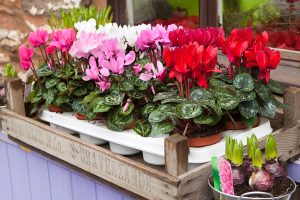Forget the calendar. What around you demonstrates the time of year? Early fall, prior to the holiday rush, is the time for fragrance and love-shaped leaves. While many plants are going to sleep, cyclamen are moving to center stage to brighten the holiday season beyond blowup reindeer and icicle lights.
Cyclamen species hail from the Middle East and Mediterranean climates. Wild varieties appeared in England and then spread across Europe to Germany in the 1860s. These cultivars had larger flowers and more colors. The name cyclamen is derived from the Greek root word for circle or “cycl.” It describes the cyclamen’s tuber which is shaped like a flattened circle. The Greeks believed food prepared with cyclamen would make a person fall in love, cause babies to be born sooner, and cure baldness. Do not rush out to purchase cyclamen for a receding hairline. The tubers are toxic and the bodily response will not improve hairlines or love affairs; in fact, quite the opposite.
Cyclamen have gained popularity as a holiday plant, grown in protected areas or indoors. Flowers and leaves have attractive attributes. The twenty-plus species range in size from six to sixteen inches tall with a variety of colors including red, white, pink, lavender, purple, and magenta. Flower shapes include single, double, fringed, and frilled. Leaves are heart-shaped with various shades of silver, white, and green. The tuber creates a mounding plant with flowers emerging from the center of the circular tuber. Large group plantings are spectacular for the holiday landscape.
Bright, indirect sunlight and cool temperatures keep your cyclamen happy. If night temperatures fall below 50 degrees, move your plants to a protected shady area against your house or in a covered porch. Indoors, plants need to be away from vents or fireplaces. Temperatures over 70 degrees will stop bud or flower production.
Cyclamen are very persnickety about watering. Only water when soil feels dry; apply water to the edge of the pot, not directly on the tuber. You may also water by filling the saucer, allowing the water to wick up to the roots. Cyclamen tubers will rot if overwatered. But, do not let your cyclamen severely wilt. Being too dry or too wet will cause unhappy, wanting-to-die plants.
As flowers and then leaves begin to die back in spring, allow the plant to dry out for several months. Tip the pot on its side in the shade if sprinklers or rain are going to hit it consistently. Provide bright, indirect light and repot with fresh potting soil and a little bigger pot prior to your plant awakening. Begin watering in August or September while watching for new growth. In September, you should see new sprouts of leaves. As leaves develop, water lightly and fertilize regularly.
As flowers die, deadhead by grabbing the spent flower by the stem. Pull it off the crown of the plant completely. If you wait to remove the spent flowers they become slimy. Garden gloves are appreciated for this task.
Whether you try propagating cyclamen from seed or tuber division, or enjoy a trip to the nursery prior to the holidays, cyclamen will help make the holidays bright and beautiful.
Julie Silva is a University of California Cooperative Extension Master Gardener of Tuolumne County.

